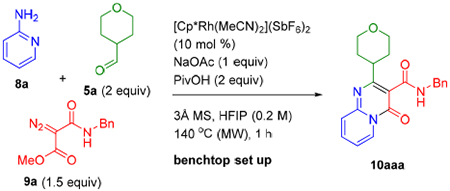Table 1.
Reaction Parameters for Annulation to 10aaaa
 | ||
|---|---|---|
| entry | variation | Yield %b |
| 1 | none | 73 (74)c |
| 2 | 0.1 mmol 5a + 2 equiv 8a +1.5 equiv 9a | 55 |
| 3 | [Cp*RliCl2]2 (5%) | 65 |
| 4 | no Rh | 0 |
| 5 | PivOH (1 equiv) | 71 |
| 6 | PivOH (0.5 equiv) | 68 |
| 7 | no PivOH | 48 |
| 8 | AcOH instead of PivOH | 57 |
| 9 | no NaOAc | 60 |
| 10 | 150 °C | 73 |
| 11 | TFE as solvent | 70 |
| 12 | EtOH as solvent | 10 |
| 13 | dioxane as solvent | 4 |
| 14 | 0.4 M | 61 |
| 15 | 0.1 M | 74 |
| 16 | [Cp*Rh(MeCN)3](SbF6)2 (5%) | 72 |
| 17 | [Cp*Rh(MeCN)3](SbF6)2(2%), 150 °C | 65 |
| 18 | no sieves | 68 |
| 19 | conventional heating, 100 °C, 20 h | 70 (72%)c |
| 20 | [Cp*Co(MeCN)3](SbF6)2 (10%) | 0 |
| 21 | [Cp*IrCl2]2 (5%) and AgSbF6 (20%) | 72 |
Conditions: 8a (0.10 mmol), 5a (0.20 mmol), 9a (0.15 mmol).
Yields determined by 1H NMR integration relative to 1,3,5-trimethoxybenzene as external standard.
Isolated yield at 0.30 mmol scale of limiting reagent 8a.
